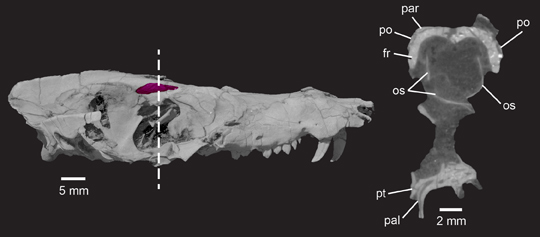A Very Mammal-like Cynodont from Argentina
Pseudotherium argentinus – A Very Mammal-like Cynodont from the Triassic of Argentina
Scientists have described a new species of cynodont, from a single, well-preserved skull found in north-western Argentina. The animal has been named Pseudotherium argentinus and although this animal was not a mammal, the skull shows some very mammal-like characteristics. For example, the cochlea is elongated but uncoiled and this feature is reminiscent of basal mammaliamorphs, the lineage that was to lead to true mammals and of course, ultimately, our own species.
CT Scan (Right Lateral View of the Skull of Pseudotherium argentinus

Picture credit: PLOS One
A Cynodont Helping to Unravel Mammal Evolution
Classified as a member of the Probainognathia, one of two clades within the Infraorder Eucynodontia, which includes modern mammals, the skull shows an enlarged braincase, large eye-sockets and other anatomical traits that indicate that this animal might have been developing the heightened senses associated with more advanced therapsids.
The fossil was found in 2006 during a field trip to the Ischigualasto Formation carried out by the Instituto y Museo de Ciencias Naturales of the Universidad Nacional de San Juan. The strata in this region is believed to be between 231 and 226 million years old approximately. The researchers conclude that Pseudotherium, the name means “false wild beast [mammal]” in reference to its mammal-like skull, may lie just inside or very close to the Mammaliamorpha, indicating that it might be a transitional form between the Probainognathia and basal mammals.
Many of the mammal-like cynodont specimens known, have badly crushed and deformed skulls. Their state of preservation prevents palaeontologists from identifying key anatomical changes leading to more advanced therapsids. The research team hope to recover more specimens from the Ischigualasto Formation which will shed further light on the evolution of our early mammal ancestors.
The scientific paper: “First record of a basal mammaliamorph from the early Late Triassic Ischigualasto Formation of Argentina” by Rachel V. S. Wallace, Ricardo Martínez and Timothy Rowe published in PLOS One.
Visit the Everything Dinosaur website: Everything Dinosaur.

